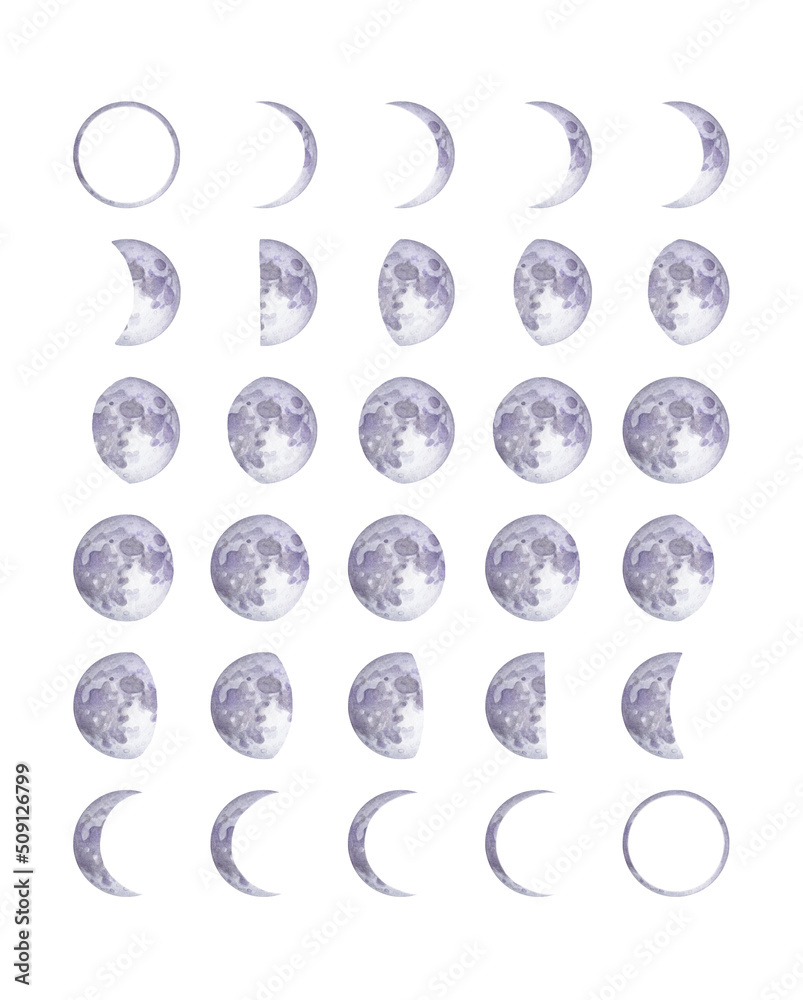Moon Calendar Set Of Moon Phases Stock Image Image Of Black Bright

Watercolor Moon Calendar Moon Phases On White Background Stock About 59% of the surface of the moon is visible from earth, owing to the different angles at which the moon can appear in earth's sky (libration), making parts of the far side of the moon visible. The moon makes earth more livable, sets the rhythm of ocean tides, and keeps a record of our solar system's history. explore nasa lunar science here.

Moon Calendar Set Moon Phases Elements Stock Photo 1713771634 Learn how earth's moon formed, how its orbit affects earth's tides, why solar and lunar eclipses happen and the history of lunar exploration. How big is the moon? the moon is earth’s only permanent natural satellite, and it’s the fifth largest satellite in our solar system. the moon’s diameter is approximately 2,160 miles (3,475. Live science brings you the best moon facts and answers all of your lunar queries, from how did the moon form and whether the moon could ever be pushed from orbit to what is the "man in the. We see the full moon when the sun is directly behind us, illuminating a full hemisphere of the moon when it is directly in front of us.

Premium Vector Phases Of The Moon On Black And White Backgrounds Live science brings you the best moon facts and answers all of your lunar queries, from how did the moon form and whether the moon could ever be pushed from orbit to what is the "man in the. We see the full moon when the sun is directly behind us, illuminating a full hemisphere of the moon when it is directly in front of us. Moon, earth’s sole natural satellite and nearest celestial body. known since prehistoric times, it is the brightest object in the sky after the sun. its name in english, like that of earth, is of germanic and old english derivation. The earth and moon are tidally locked. their rotations are so in sync we only see one side of the moon. humans didn't see the lunar far side until a soviet spacecraft flew past in 1959. the moon has a solid, rocky surface cratered and pitted from impacts by asteroids, meteorites, and comets. The moon (or luna) is the earth’s only natural satellite and was formed 4.6 billion years ago around some 30–50 million years after the formation of the solar system. A moon is an object that orbits a planet or something else that is not a star. besides planets, moons can circle dwarf planets, large asteroids, and other bodies. objects that orbit other objects are also called satellites, so moons are sometimes called natural satellites.

Premium Photo Watercolor Moon Calendar Moon Phases On Black Background Moon, earth’s sole natural satellite and nearest celestial body. known since prehistoric times, it is the brightest object in the sky after the sun. its name in english, like that of earth, is of germanic and old english derivation. The earth and moon are tidally locked. their rotations are so in sync we only see one side of the moon. humans didn't see the lunar far side until a soviet spacecraft flew past in 1959. the moon has a solid, rocky surface cratered and pitted from impacts by asteroids, meteorites, and comets. The moon (or luna) is the earth’s only natural satellite and was formed 4.6 billion years ago around some 30–50 million years after the formation of the solar system. A moon is an object that orbits a planet or something else that is not a star. besides planets, moons can circle dwarf planets, large asteroids, and other bodies. objects that orbit other objects are also called satellites, so moons are sometimes called natural satellites.
Comments are closed.